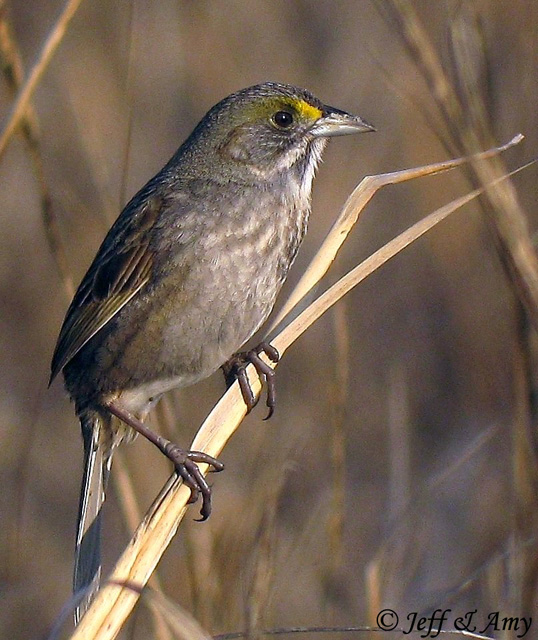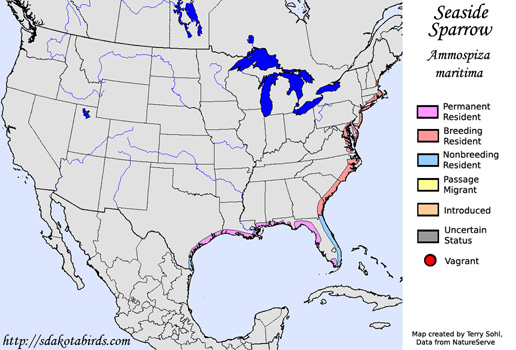Seaside Sparrow
Ammospiza maritima
| Length: 6 inches | Wingspan: 7.5 inches | Seasonality: Non-resident in South Dakota |
| ID Keys: Grayish overall with yellow lores, streaks on back, white throat, long bill. Gulf Coast, Sable, and Atlantic populations differ in plumage characteristics. | ||
 The
Seaside Sparrow is an aptly named sparrow species found in tidal marsh areas
along the Gulf and Atlantic coasts of the United States. Habitats of
the species are disjunct, with scattered pockets in suitable habitat.
Separation of individual populations have led to multiple local races of
Seaside Sparrow, each with unique plumage and voice characteristics.
One of these, the "Dusky Seaside Sparrow", formerly found in Florida, is
presumed extinct. The "Cape Sable" Seaside Sparrow is found in
southern Florida, and has much whiter underparts than the other races, with
very obvious dark streaking. The "Gulf Coast" race has very distinct
streaks on its back, and a buffy breast with strong streaking. The
"Atlantic" race is duller and more gray overall, with streaking that is less
noticeable (see photo to the right for an Atlantic race Seaside Sparrow).
The
Seaside Sparrow is an aptly named sparrow species found in tidal marsh areas
along the Gulf and Atlantic coasts of the United States. Habitats of
the species are disjunct, with scattered pockets in suitable habitat.
Separation of individual populations have led to multiple local races of
Seaside Sparrow, each with unique plumage and voice characteristics.
One of these, the "Dusky Seaside Sparrow", formerly found in Florida, is
presumed extinct. The "Cape Sable" Seaside Sparrow is found in
southern Florida, and has much whiter underparts than the other races, with
very obvious dark streaking. The "Gulf Coast" race has very distinct
streaks on its back, and a buffy breast with strong streaking. The
"Atlantic" race is duller and more gray overall, with streaking that is less
noticeable (see photo to the right for an Atlantic race Seaside Sparrow).
Habitat: Found in tidal salt marshes near the coast, usually in areas with dense, tall vegetation growth.
Diet: Feeds on insects, spiders, and seeds, as well as other invertebrates along the coast such as tiny craps, snails, and marine worms. Seeds make up a large portion of the diet during the winter months.
Behavior: Forages by moving along the ground or in low vegetation growth, probing for insects and other prey creatures.
Nesting: The nest of a Seaside Sparrow is a cup built of grasses, placed in low vegetation near the shoreline. The female usually lays 3 or 4 eggs, and she alone incubates them. After the eggs hatch, both parents help to feed the young, who leave the nest after about 10 days. In some parts of their range, they may raise more than one brood in a given year.
Song: Song of a Seaside Sparrow is short and relatively quiet, consisting of three phrases ending in a buzzing note.
Migration: Many birds are permanent residents. However, birds in the northern part of the range do move southward in winter, and birds are found further south in Florida and Texas in winter.
Interactive eBird Map: Click here to access an interactive eBird map of Seaside Sparrow sightings
Similar Species: In range, most likely to be confused with Saltmarsh Sparrow, Nelson's Sparrow, or Savannah Sparrow.
Conservation Status: Populations may be decreasing, but they are still found over a wide geographic range and are relatively common in appropriate habitat. The IUCN lists the Seaside Sparrow as a species of "Least Concern".
Further Information: 1) New York State Dept. of Environmental Conservation - Seaside Sparrow
2) Audubon Guide - Seaside Sparrow
3) South Carolina DNR - Seaside Sparrow
Photo Information: Photo taken on April 26th, 2009 at Prime Hook NWR in Delaware - Photo by Jeff & Amy - Photo licensed under Creative Commons Attribution NonCommercial 2.0 Generic License.
| Click below for a higher-resolution map |
 |
| South Dakota Status: Non-resident in South Dakota |
Additional Seaside Sparrow Photos (coming soon!!)
